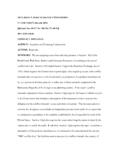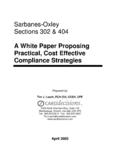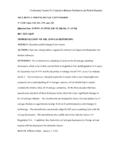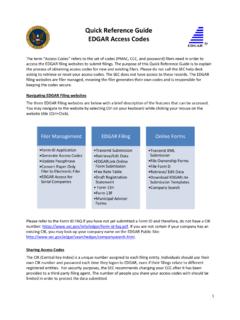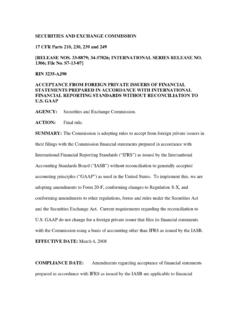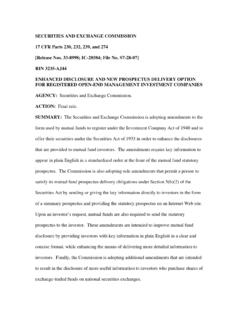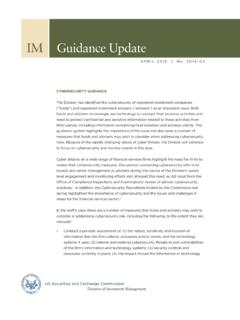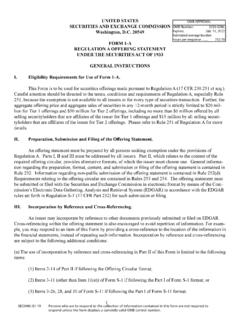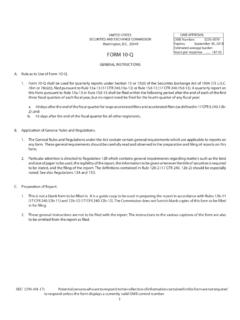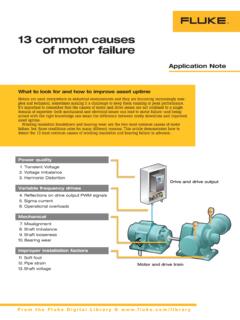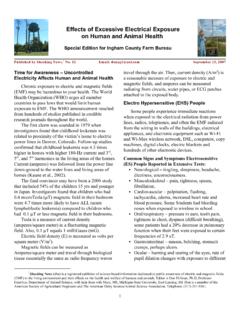Transcription of Investor Bulletin: How Fees and Expenses Affect Your ...
1 Investor Assistance (800) 732-0330 BULLETINHow Fees and Expenses Affect your investment portfolio The SEC s Office of Investor Education and Advocacy is issuing this bulletin to educate investors about how fees can impact the value of an investment portfolio . As with anything you buy, there are fees and costs associated with investment products and services. These fees may seem small, but over time they can have a major impact on your investment portfolio . The following chart shows an investment portfolio with a 4% annual return over 20 years when the investment either has an ongoing fee of , or 1%. Notice how the fees Affect the investment portfolio over 20 Value From Investing $100,000 Over 20 YearsInvestor Assistance (800) 732-0330 with the other factors you think about when choos-ing either a financial professional or a particular investment , be sure you understand and compare the fees you ll be charged.
2 It could save you a lot of money in the long run. How do I know what I m being charged?n Get informed. Find out what you may be charged by reading what your financial professional provides you. For example, look at your account opening documents, account statements, confirmations and any product-specific documents to see the types and amount of fees you are paying. Fees impact your investment , so it s important you understand them. n Ask questions so that you understand what you will be charged, when and why. Questions might include:n What are all the fees relating to this account? Do you have a fee schedule that lists all of the fees that will be charged for investments and maintenance of this account?
3 N What fees will I pay to purchase, hold and sell this investment ? Will those fees appear clearly on my account statement or my confirmation? If those fees don t appear on my account statement or my confirmation, how will I know about them?n How can I reduce or eliminate some of the fees I ll pay? For example, can I buy the investment directly without paying a financial professional? Can I pay lower fees if I open a different type of account?n Do I need to keep a minimum account balance to avoid certain fees?n Are there any other transaction or advisory fees? Account transfer, account inactivity, wire transfer fees or any other fees?n How do the fees and Expenses of the product compare to other products that can help me meet my objectives?
4 N How much does the investment have to increase in value before I break even?n Ask questions about your financial professional s compensation. Questions might include:n How do you get paid? By commission? How are commissions determined? Do they vary depend-ing on the amount of assets you manage? n Do you get paid through means other than through commissions and amount of assets you manage and, if yes, how? n Do I have any choice on how to pay you? n Check your statements. Review confirmation and account statements to be sure you re being charged correctly and ask your financial professional to break the fees down for you if it s types of fees are there?Fees typically come in two types transaction fees and ongoing fees.
5 Transaction fees are charged each time you enter into a transaction, for example, when you buy a stock or mutual fund. In contrast, ongoing fees or Expenses are charges you incur regularly, such as an annual account maintenance fee. How do transaction fees Affect your investment portfolio ?Transaction fees are charged at the time you buy, sell or exchange an investment . As with any fee, transaction fees will reduce the overall amount of your investment portfolio . 2 Investor Assistance (800) 732-0330 do ongoing fees Affect your investment portfolio ?Ongoing fees can also reduce the value of your investment portfolio . This is particularly true over time, because not only is your investment balance reduced by the fee, but you also lose any return you would have earned on that fee.
6 Over time, even ongoing fees that are small can have a big impact on your investment portfolio . The chart above illustrates the effect of different ongoing fees on a $100,000 investment portfolio with a 4% annual return over 20 years. The chart below illustrates the impact of a 1% ongoing fee on a $100,000 investment portfolio that grows 4% annually over 20 years. As the investment portfolio grows over time, so does the total amount of fees you pay. Because of the fees you pay, you have a smaller amount invested that is earning a return. Illustration of Ongoing Fees Over 20 Years3 Investor Assistance (800) 732-0330 is an example of a transaction fee?Commissions. You will likely pay a commission when you buy or sell a stock through a financial professional.
7 The commission compensates the financial professional and his or her firm when it is acting as agent for you in your securities transaction. Markups. When a broker-dealer sells you securities out of its inventory, the broker-dealer acts as a principal in the transaction (that is, selling to you directly the securities it holds). When acting in a principal capacity the broker-dealer generally will be compensated by selling the security to you at a price that is higher than the market price (the difference is called a markup), or by buying the security from you at a price that is lower than the market price (the difference is called a markdown). Sales loads. Some mutual funds charge a fee called a sales load.
8 Sales loads serve a similar purpose to commissions by compensating the financial professional for selling the mutual fund to you. Sales loads can be front-end in that they are assessed at the time you make your investment or back-end in that you are assessed the charge if you sell the mutual fund usually within a specified timeframe. Surrender charges. Early withdrawal from a variable annuity investment (typically within six to eight years, but sometimes as long as 10 years) will usually result in a surrender charge. This charge compensates your financial professional for selling the variable annuity to you. Generally, the surrender charge is a percentage of the amount withdrawn, and declines gradually over a period of several is an example of an ongoing fee?
9 investment advisory fees. If you use an investment adviser to manage your investment portfolio , your adviser may charge you an ongoing annual fee based on the value of your portfolio . Annual operating Expenses . Mutual funds and exchange-traded funds, or ETFs, are essentially investment products created and managed by investment professionals. The management and marketing of these investment products result in Expenses and costs that are often passed on to you the Investor in the form of fees deducted from the fund s assets. These annual ongoing fees can include management fees, 12b-1 or distribution (and/or service) fees, and other Expenses . These fees are often identified as a percentage of the fund s assets the fund s expense ratio (identified in the fund s prospectus as the total annual fund operating Expenses ).
10 401(k) fees. The Expenses for operating and administer-ing 401(k) plans may be passed along to its participants. This is in addition to the annual operating Expenses of the mutual fund investments that you may hold in your variable annuity fees. If you invest in a variable annuity, you may be charged fees to cover the Expenses of administering the variable annuity. You also may pay fees such as insurance fees and fees for optional features (often called riders). You will also be subject to the annual operat-ing Expenses of any mutual funds or other investments that the variable annuity holds. What are some examples of products with combined transaction and ongoing fees?Some investment products or services, including mutual funds, ETFs and variable annuities, commonly include both transaction and ongoing fees as part of the structure of the product or service.

